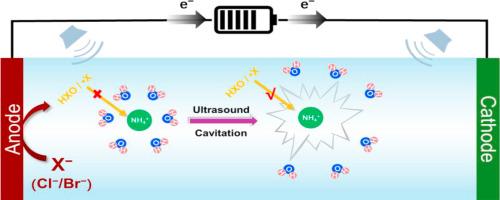当前位置:
X-MOL 学术
›
Water Res.
›
论文详情
Our official English website, www.x-mol.net, welcomes your
feedback! (Note: you will need to create a separate account there.)
Highly efficient electrochemical oxidation of ammonium in strong acid via low-frequency sonication: The role of ammonium desolvation
Water Research ( IF 11.4 ) Pub Date : 2025-05-30 , DOI: 10.1016/j.watres.2025.123937
Haojun Ma, Weijian Duan, Li Tian, Wuwei Wang, Chunhua Feng
Water Research ( IF 11.4 ) Pub Date : 2025-05-30 , DOI: 10.1016/j.watres.2025.123937
Haojun Ma, Weijian Duan, Li Tian, Wuwei Wang, Chunhua Feng

|
The use of electrochemical advanced oxidation process (EAOP) for treating NH4+-rich wastewater via reactive halogen species offers a promising alternative to biological methods but faces challenges in strong acid due to poor NH4+ oxidation kinetics. Herein, we identify the strong solvation of NH4+ as the key limiting factor, where surrounding H2O molecules form a protective shield that hinders oxidative species. To address this, low-frequency sonication (LFS, e.g., 40 kHz) was introduced, disrupting the solvation environment through cavitation and enhancing NH4+ exposure to oxidative species. At pH 2, electrolysis alone exhibited only 8.0–28.8% NH4+ oxidation efficiency within 2.5 h, while this value significantly improved (60.73–100%) in the LFS-Cl/EAOP systems and reached 100% in the LFS-Br/EAOP systems. The LFS-Cl/EAOP systems showed strong dependence on anode materials, with boron-doped diamond (BDD) and PbO2 outperforming mixed metal oxides (MMO) and Pt; in contrast, the LFS-Br/EAOP systems achieved high NH4+ removal regardless of anode type. It is further revealed that bromate formation was suppressed by rapid HBrO consumption and cathodic reduction. Moreover, the feasibility of complete NH4+ elimination and acid solution regeneration for NH3 adsorption via LFS-Br/EAOP was demonstrated, highlighting its potential for practical application.
中文翻译:

通过低频超声处理对强酸中的铵进行高效电化学氧化:铵脱溶剂化的作用
使用电化学高级氧化工艺 (EAOP) 通过反应性卤素物质处理富含 NH4+ 的废水,为生物方法提供了一种很有前途的替代方案,但由于 NH4+ 氧化动力学较差,在强酸中面临挑战。在此,我们确定 NH4+ 的强溶剂化是关键限制因子,其中周围的 H2O 分子形成阻碍氧化物质的保护屏障。为了解决这个问题,引入了低频超声处理(LFS,例如 40 kHz),通过空化破坏溶剂化环境并增强 NH4+ 对氧化物质的暴露。在 pH 值为 2 时,单独电解在 2.5 小时内仅表现出 8.0-28.8% 的 NH4+ 氧化效率,而该值在 LFS-Cl/EAOP 系统中显著提高 (60.73-100%),在 LFS-Br/EAOP 系统中达到 100%。LFS-Cl/EAOP 系统表现出对负极材料的强烈依赖性,硼掺杂金刚石 (BDD) 和 PbO2 的性能优于混合金属氧化物 (MMO) 和 Pt;相比之下,LFS-Br/EAOP 系统无论阳极类型如何,都能实现高 NH4+ 去除率。进一步揭示溴酸盐的形成被快速 HBrO 消耗和阴极还原所抑制。此外,还证明了通过 LFS-Br/EAOP 完全消除 NH4+ 和酸溶液再生用于 NH3 吸附的可行性,突出了其实际应用的潜力。
更新日期:2025-05-31
中文翻译:

通过低频超声处理对强酸中的铵进行高效电化学氧化:铵脱溶剂化的作用
使用电化学高级氧化工艺 (EAOP) 通过反应性卤素物质处理富含 NH4+ 的废水,为生物方法提供了一种很有前途的替代方案,但由于 NH4+ 氧化动力学较差,在强酸中面临挑战。在此,我们确定 NH4+ 的强溶剂化是关键限制因子,其中周围的 H2O 分子形成阻碍氧化物质的保护屏障。为了解决这个问题,引入了低频超声处理(LFS,例如 40 kHz),通过空化破坏溶剂化环境并增强 NH4+ 对氧化物质的暴露。在 pH 值为 2 时,单独电解在 2.5 小时内仅表现出 8.0-28.8% 的 NH4+ 氧化效率,而该值在 LFS-Cl/EAOP 系统中显著提高 (60.73-100%),在 LFS-Br/EAOP 系统中达到 100%。LFS-Cl/EAOP 系统表现出对负极材料的强烈依赖性,硼掺杂金刚石 (BDD) 和 PbO2 的性能优于混合金属氧化物 (MMO) 和 Pt;相比之下,LFS-Br/EAOP 系统无论阳极类型如何,都能实现高 NH4+ 去除率。进一步揭示溴酸盐的形成被快速 HBrO 消耗和阴极还原所抑制。此外,还证明了通过 LFS-Br/EAOP 完全消除 NH4+ 和酸溶液再生用于 NH3 吸附的可行性,突出了其实际应用的潜力。


















































 京公网安备 11010802027423号
京公网安备 11010802027423号